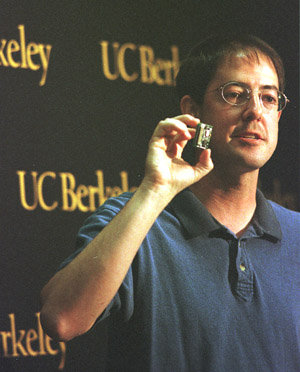|
HOME | SEARCH | ARCHIVE |
|
'Smart' sensor technologies promise big savings in state energy costs
![]()
By Diane Ainsworth, Public Affairs
| |  Professor Kris Pister displays a smart sensor installed in Cory Hall on the UC Berkeley campus. Noah Berger photo |
25 May 2001
|
In a show of new energy-efficient technologies that researchers say are capable of cutting California's annual electricity bill by $5 billion to $7 billion each year, UC Berkeley on Friday unveiled a network of tiny, wireless sensors that can save electricity by monitoring lighting and room temperatures. The diminutive sensors, each no bigger than a matchbook, were tucked into the corners of offices, placed along hallways and mounted in conference rooms throughout two floors of Cory Hall, Berkeley's electrical engineering building. At a press conference, researchers with the proposed Center for Information Technology Research in the Interest of Society, known as CITRIS, showed how the network of "smart dust motes," when coupled with sophisticated software, can measure room conditions continuously and help building technicians curb energy use. "Our researchers have developed a prototype energy management technology that can eventually be deployed for less than $1 per sensor," said Richard Newton, dean of the College of Engineering. "The sensors you find today are relatively large, but we think we can get these devices down to the size of a penny or smaller. "Imagine a network of them, all communicating with each other automatically and wirelessly, to control the energy consumption in a room or a building," Newton said. "This is a quantum change in our ability to monitor and to deploy these sorts of networks." The goal of CITRIS research is to develop information technologies like this that can readily be put to use to solve large-scale societal problems affecting the quality of life, such as the energy shortage. Inexpensive technologies to monitor information can be applied to many environmental problems, such as controlling traffic congestion, measuring the movement of buildings during an earthquake or maintaining heating and cooling systems in office buildings. With continued development and miniaturization, CITRIS technologies will also have an impact on health care and distance learning. One of Gov. Gray Davis' proposed California Institutes for Science and Innovation, CITRIS is slated to receive $33 million in initial state funding from next year's proposed budget, still under negotiation in the state legislature. In preparation for today's demonstration, Berkeley electrical engineering professor Jan Rabaey, fellow scientists and graduate students installed more than 50 solar and battery-powered smart dust motes in Cory Hall, an older building housing the Department of Electrical Engineering and Computer Sciences and its array of energy-hungry computers and equipment for research and teaching. The prototype sensors, which cost about $100 each to build, were outfitted with wireless radio transceivers and their own miniature operating systems to transmit continuous lighting and temperature readings to a computer and help facilities managers monitor the building's electricity usage. "These sensors are essentially little wireless computers with radio chips and batteries that generate information about the environment continuously," said electrical engineering professor Kris Pister, developer of the smart dust sensors. "What's unique about these platforms is the tiny operating system, which makes them 'smart' and gives them the ability to operate autonomously." By monitoring temperature and light over the entire floor in real time, building technicians can determine how much electricity people need during the week, Pister said. Such a network could someday be a significant cost-saver to residential consumers, who would be able to monitor their own electricity, gas, heating and water usage, and more accurately control their rates of consumption. Pister said the Berkeley researchers plan, by this summer, to have developed an autonomous sensor node with a tiny computer onboard, its own power supply, and two-way communication capability, all in a device that measures about 1 cubic millimeter. The researchers believe they are very close to putting smart energy technologies to work. Commercialization of the current, matchbook-sized chips would take about two years, Pister said, and they could be manufactured by the thousands, millions or billions. Researchers are probably only about five years away from bringing the next generation of button-sized smart sensors to the marketplace, he said. "By using an inexpensive sensor network on the Berkeley campus, we would be saving about $900,000 a year in electricity costs and cutting our power use by at least 5 percent," Pister said. Newton, the engineering dean, estimated that energy savings nationwide from use of such a monitoring system would be about $35 billion or more, which would translate into a reduction of about 30,000 tons of carbon emissions each year. Once buildings are outfitted with smart sensor systems, Pister said, the passive sensors could be designed to perform more and more intelligently. For instance, the next generation of smart dust motes may be sophisticated enough to cut power automatically, but only to certain devices and at certain peak hours of the day. "Everything should have its own built-in intelligence," Pister said. "Wouldn't people rather spend several hours a day with their power intelligently reduced by 20 percent instead of having a one-in-five chance that they'll be cut off entirely as part of a rolling black out? With these smart sensors in place, the critical equipment could continue to operate during a blackout." CITRIS research depends on industry partnerships, a key component of Davis' new California Institutes for Science and Innovation. As one of these new University of California institutes, CITRIS is a partnership between California industry, Berkeley and the UC campuses at Davis, Santa Cruz and Merced. Legislation to fund CITRIS may be passed into law in Sacramento next month.
Links:
CITRIS Web siteCampus News Feature on CITRIS
Smart sensor press release
Home | Search | Archive | About | Contact | More News
Copyright 2000, The Regents of the University of California.
Produced and maintained by the Office of Public Affairs at UC Berkeley.
Comments? E-mail berkeleyan@pa.urel.berkeley.edu.